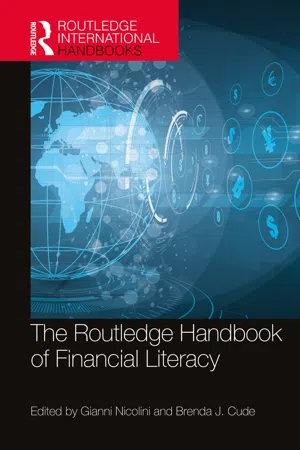
The Routledge Handbook of Financial Literacy
Gianni Nicolini, Brenda J. Cude, Gianni Nicolini, Brenda J. Cude
- 540 pagine
- English
- ePUB (disponibile sull'app)
- Disponibile su iOS e Android
The Routledge Handbook of Financial Literacy
Gianni Nicolini, Brenda J. Cude, Gianni Nicolini, Brenda J. Cude
Informazioni sul libro
Financial literacy and financial education are not new topics, even though interest in these topics among policymakers, financial authorities, and academics continues to grow. The Routledge Handbook of Financial Literacy provides a comprehensive reference work that addresses both research perspectives and practical applications to financial education. This is the first volume to summarize the milestones of research in financial literacy from multiple perspectives to offer an overview.
The book is organized into six parts. The first three parts provide a conceptual framework, which discusses what financial literacy is, how it should be measured, and explains why it represents a relevant topic and effective tool in enhancing decision-making among consumers as well as consumer protection strategies. Part IV addresses the connection between financial education and financial literacy, with chapters about financial education in school settings as well as for adults. This part includes an analysis of the role of Fintech and the use of gamification in financial education. Part V is a collection of contributions that analyze financial literacy and financial education around the world, with a focus on geographical areas including the U.S., South America, Western Europe, Eastern Europe, Asia, and Africa. This part also considers how financial literacy should be addressed in the case of Islamic finance. The concluding part of the book examines how financial literacy is related to other possible approaches to consumer finance and consumer protection, addressing the relationships between financial literacy and behavioral economics, financial well-being, and financial inclusion.
This volume is an indispensable reference for scholars who are new to the topic, including undergraduate and graduate students, and for experienced researchers who wish to enrich their knowledge, policymakers seeking a broader understanding and an international perspective, and practitioners who seek knowledge of best practices as well as innovative approaches.
Domande frequenti
Informazioni
Part IWhat is financial literacy?
1Defining financial literacy
Introduction
Definitions of financial literacy
the process by which people improve their understanding of financial products, services and concepts, so they are empowered to make informed choices, avoid pitfalls, know where to go for help and take other actions to improve their present and long-term financial well-being.(PACFL, 2008)
the process by which financial consumers/investors improve their understanding of financial products and concepts and, through information, instruction and/or objective advice, develop the skills and confidence to become more aware of financial risks and opportunities, to make informed choices, to know where to go for help, and to take other effective actions to improve their financial well-being.(p. 26)
Financial literacy is a measure of the degree to which one understands key financial concepts and possesses the ability and confidence to manage personal finances through appropriate, short-term decision-making and sound, long-range financial planning, while mindful of life events and changing economic conditions.(p. 284)
Indice dei contenuti
- Cover
- Half-Title Page
- Title Page
- Copyright Page
- Contents
- List of figures
- List of tables
- List of contributors
- Introduction
- Part I What is financial literacy?
- Part II Measuring financial literacy
- Part III Relevance and effectiveness of financial literacy
- Part IV Improving financial literacy: The role of financial education
- Part V Financial literacy and financial education around the world
- Part VI Beyond financial literacy
- Index